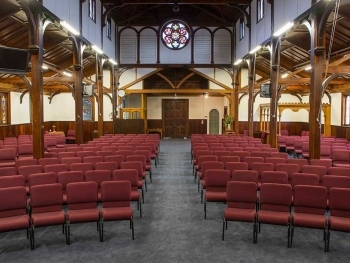Chapels, with their serene atmosphere and rich history, serve as places for prayer, reflection, and gathering. Within these sacred spaces, every element contributes to the experience, and chapel seating plays a crucial role. It provides a place for congregants to find comfort and focus during services, weddings, funerals, and moments of quiet contemplation.
This guide delves into the world of chapel seating, exploring its various styles, materials, considerations for comfort and functionality, and how to choose the perfect seating for your chapel.
Traditional Options: Pews and Kneeling Benches
- Pews: The quintessential chapel seating, pews offer a sense of history and tradition. Typically constructed from wood, they provide a continuous bench with a backrest for multiple people. Pews can be upholstered for added comfort, and some offer hinged seats for storage underneath.
- Kneeling Benches: Often found in Catholic chapels, kneeling benches are typically lower than pews and lack backrests. They allow congregants to alternate between sitting and kneeling postures during prayer.
Considerations for Traditional Seating:
- Comfort: While traditional, pews can be uncomfortable for long periods, especially if not upholstered. Kneeling benches may also pose challenges for those with limited mobility.
- Flexibility: Pews are not easily reconfigurable, limiting the chapel's layout options for different events.
- Aesthetics: Traditional seating complements chapels with classic architecture. However, worn or damaged pews can detract from the overall ambiance.
Modern Alternatives: Chairs and Movable Seating
- Church Chairs: Churches are increasingly opting for chairs, offering greater comfort and flexibility. Upholstered chairs with backs provide good support, while some un-upholstered wooden chairs maintain a traditional aesthetic.
- Movable Seating: Movable chairs allow for greater flexibility in arranging the chapel layout. Stackable chairs are a space-saving option, while ganging chairs together can create pew-like rows.
Considerations for Modern Seating:
- Comfort: Choose chairs with proper back support and seat padding for extended sitting periods.
- Durability: Opt for chairs built with sturdy materials that can withstand frequent use.
- Aesthetics: Select chairs that complement the chapel's architectural style. Upholstery color and wood finishes should be considered.
- Accessibility: Ensure some seating options are accessible for those with mobility limitations.
Material Matters: Wood, Upholstery, and Beyond
- Wood: A timeless choice, wood offers a classic and elegant look. Popular wood options include oak, maple, and cherry. Consider the wood's stain or finish to match the chapel's aesthetics.
- Upholstery: Upholstered seating provides superior comfort, especially for long services. Choose durable and easy-to-maintain fabrics like wool or synthetic blends.
- Alternative Materials: For a contemporary touch, some chapels incorporate metal or plastic chairs. These materials can be lightweight and affordable but may not offer the same level of comfort or aesthetic appeal as wood.
Functionality and Considerations
- Space Optimization: Consider the size of your chapel and the number of congregants you typically accommodate. Factor in aisle space and accessibility needs when choosing seating dimensions.
- Storage: If pews are chosen, consider models with built-in storage for hymnals or other materials.
- Maintenance: Choose materials and designs that are easy to clean and maintain. Upholstery should be stain-resistant, and wood finishes should be durable.
- Acoustics: Solid wood pews can absorb sound, while upholstered chairs may reflect it. Consider the impact of seating material on the chapel's acoustics.
Choosing the Right Seat: A Balancing Act
Selecting chapel seating requires careful consideration of various factors. Here's a breakdown to guide you:
- Traditional vs. Modern: Consider the architectural style of your chapel and the desired atmosphere. Traditional seating complements classic architecture, while modern options offer flexibility and comfort.
- Comfort vs. Durability: Find a balance between comfortable seating that encourages prayer and reflection, and durable materials that can withstand frequent use.
- Budget: Chapel seating can range from cost-effective chairs to custom-designed pews. Determine your budget and prioritize features accordingly.
Additional Considerations:
- Talk to your congregation: Gather feedback from congregants regarding their preferences for comfort and functionality.
- Consult a specialist: Consider seeking advice from a church furniture expert to discuss options and ensure proper installation.
By carefully considering these factors, you can choose chapel seating that provides comfort, functionality, and a beautiful and inspiring environment for prayer and reflection.




